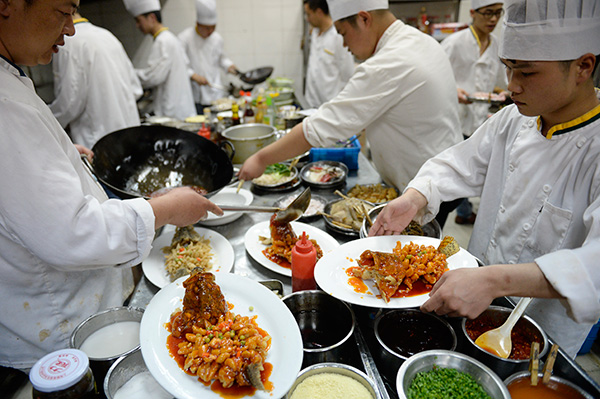Dining in the 'land of fish and rice'
 |
|
Chefs in a Suzhou restaurant prepare the city's famous dish, flying squirrel fish. [Photo by Wei Xiaohao/China Daily] |
Eight fairies in water. Three whites of Taihu Lake. Mandarin flying squirrel fish.
Indeed, Suzhou's saccharine cuisine delights with not only sugary flavors but sometimes also with the names of its delicious delicacies.
That said, the city itself is hailed as "the land of fish and rice".
The culinary cousin of Shanghai fare is genetically distinct from the gastronomy of the nearby megalopolis largely by virtue of a finer attention to detail in preparation and presentation.
Both branches of the regional su family tree of cooking are typically light and sweet, and give greater prominence to the original flavors of fresh main ingredients than to the zests contributed by condiments and seasonings.
Many of these staples come from Taihu Lake.
Suzhou's aquaculture includes not only fish, shrimp and eels but also assorted water plants, the most celebrated of which are the "eight fairies of the water"-namely, lotus roots, water caltrops, arrowheads, wild rice stems, water shields, Chinese eddo, water chestnuts and gorgon fruits.
They take their collective appellation from the fact that the hazy lotus lakes that sire them resemble those associated with traditional descriptions of the otherworld.
They're so revered that the city's Lizhi village hosts a museum exclusively devoted to their legacies.
Flying squirrel fish is perhaps the most iconic local dish created with ingredients that swim.
It takes its name from its presentation, in which a carp's flesh is sliced into dozens of bristling, quill-like projections said to resemble the namesake arboreal rodent's tail.
Its appearance is sometimes also likened to a chrysanthemum's.
This knife work isn't simply for looks. It also generates more surface area for the sweet-and-sour sauce to soak in-and makes it easier to eat.
It's said that emperor Qianlong (1711-99) adored the dish when he sampled it at Suzhou's Songhelou Restaurant. That's perhaps partly why the brand has survived and today hosts several branches throughout the city.
Eels are a staple prepared in almost every way imaginable.
They enjoy a special status since traditional medicine contends the nutrition they provide proffers homeopathic properties.
A colorful name for a trio of local aquatic offerings are the "three whites of Taihu"-whitefish, whitebait and white shrimp.
Sampling such colorfully christened delicacies will show Suzhou lives up to its name as a place of supreme cuisine-in more than name.
Related:


















